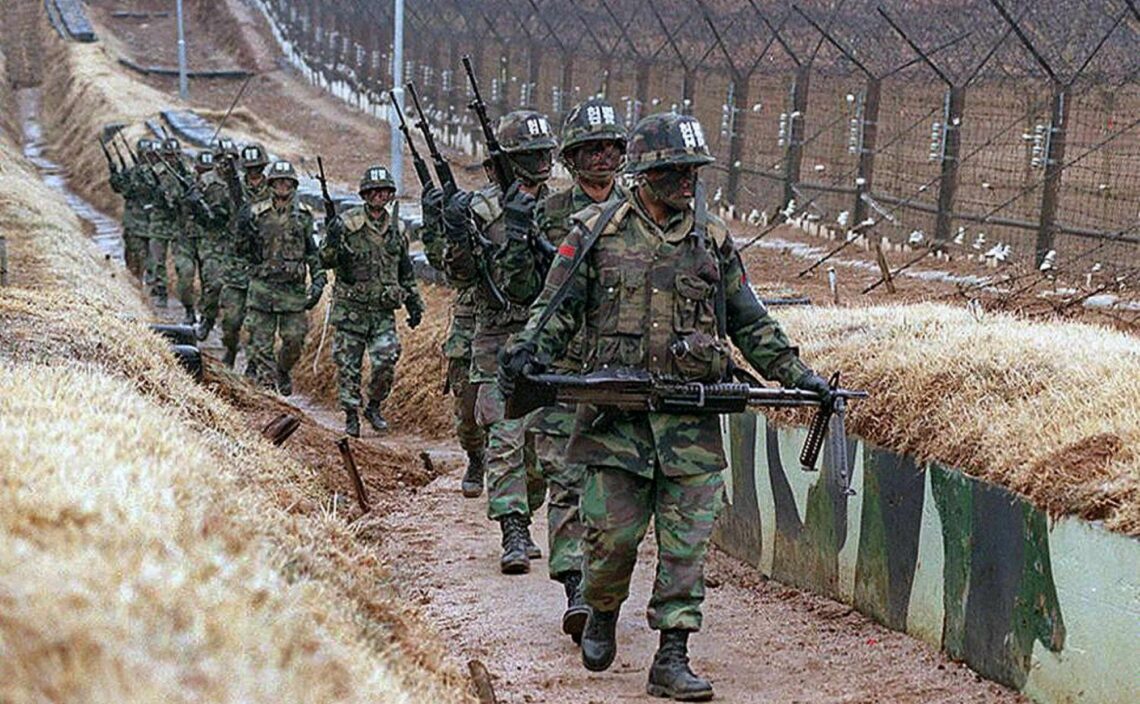Will the South Korean success story continue?
South Korea has proven that even through adversity and the constant threat of war, it can still develop and progress. That will continue to be the case if the precarious peace on the Korean Peninsula continues. But that is a big “if.”

In a nutshell
- South Korea has had enormous success over the past 50 years
- The current crisis threatens to devastate the Korean Peninsula
- Tensions will continue, but a solution is possible
- South Korea will be the biggest beneficiary of a sustainable peace
In the span of a few decades, South Korea rose from the devastation of World War II and the Korean War to join the ranks of the Organisation of Economic Development and Co-operation (OECD). Politically, the Republic of Korea transformed from a military dictatorship into a lively and fully-functioning democracy. All of this was achieved under very difficult circumstances, with the shadow of war constantly looming over the Korean Peninsula. But with old and new threats looming, how long can South Korea’s success story continue?
An economic miracle
With a population of nearly 52 million, South Korea is the 27th largest nation in the world; North Korea is about half the size. Based on purchasing power parity, South Korea ranks 14th in the world in terms of gross domestic product, at over $1.8 trillion, and ranks 33rd in the world in GDP per capita, at over $35,000. The structure of South Korea’s GDP reflects that of other industrialized economies, with agriculture contributing 2.2 percent to the national GDP, industry 38.6 percent and services 59.2 percent.
South Korea is among the world leaders in the production of consumer electronics, smartphones and LCD televisions. Its annual exports are worth $483 billion, making the country the seventh largest exporter in the world. China receives one-quarter of total South Korean exports, with the United States taking 14 percent and Japan 6 percent. 15 South Korean companies are found in the Fortune Global 500, rivaling China, and several South Korean chaebol (industrial conglomerates) have overtaken their Japanese competitors.
South Korea depends on imports for 98 percent of its fossil fuel consumption.
Like Japan, South Korea lacks raw material or energy resources. It ranks among the world’s 10 largest energy consumers and depends on imports for 98 percent of its fossil fuel consumption, all of which must reach the country by sea. Despite not having any domestic oil and gas sources, South Korea is home to some of the world’s largest and most sophisticated refineries. Securing energy supplies from overseas is a major challenge, and South Korean companies put great emphasis on long-term delivery contracts. While the lack of natural resources is certainly a handicap, it can also drive innovation and improvements in efficiency.
The weight of history
In 1948, three years after the Japanese occupation of Korea ended, the peninsula was divided into North Korea and South Korea. Although the Soviet Union contributed little to the defeat of Japanese imperialism, Joseph Stalin managed to get a share of the Northeast Asian spoils. For the newly established Republic of Korea, the beginning was extremely difficult. Two years after Korea’s own “iron curtain” separated the communist North from the free South, Pyongyang launched an invasion. For three years, the Korean people suffered one of the most devastating wars in modern history.
After the war and the partition of the Korean Peninsula by the Demilitarized Zone (DMZ), it took almost four decades for politics to settle down and the South Koreans to enjoy the benefits of liberal democracy. In the intervening years the country saw a range of political turmoil: dictatorship, military rule, political assassinations and coups. Finally, with the proclamation of the sixth republic in 1987, the country embarked on a solid course of democracy and rule of law.
It is rare for a country to escape poverty and dictatorship in this way, especially in the circumstances faced by the Republic of Korea. Stuck between two powerful neighbors in China and Japan, South Korea required determination and flexibility on the part of its people and leaders. The country has an ancient history of preserving its culture in the face of adversity, a trait that led the Japanese to try to stamp out the Korean cultural inheritance during their colonial rule.

All of that history still weighs heavily on the region. Even today, there has never been a reconciliation between Japan and Korea, unlike the case of France and Germany after World War II. With respect to North Korea, the differences with Japan are deeply ideological. But as the North Korean threat has grown, there should be no reason why Tokyo and Seoul cannot heal the wounds of the past.
While the world (and especially the United States) looks to China to increase pressure on North Korea, history reminds us that Beijing must tread carefully. China’s historical interference in the power struggles on the peninsula should lower expectations about what Beijing can accomplish.
Scenarios
What are the prospects for continued success in South Korea? For one, the country must hope for self-restraint from the world’s major powers, whose own national interests would complicate any efforts towards a sustainable solution on the peninsula. While Seoul may continue to promote an eventual reconciliation of North and South, China will have its doubts. Beijing has no interest in a sudden collapse of the impoverished North Korea.
Relations between Japan and both Koreas remain complicated. Although both Seoul and Tokyo are allies of the U.S. and share similar security concerns, there is a lack of coordination between the two countries. Many historical issues, such as the dark chapter of the “comfort women,” continue to spoil bilateral relations.
South Korea knows that Japan has no real interest in a united Korea, which would pose a serious challenge to its position as a major power in Northeast Asia, which is already under strain due to its negative demographic trends. On the other hand, Seoul also knows that Japan’s options for dealing with Pyongyang on its own are limited, if not nonexistent.
It is extremely difficult for outsiders to correctly assess the threat of war on the Korean Peninsula. We cannot know the inner workings or motives of the secretive North Korean regime. On the other side of the DMZ, despite living within range of thousands of North Korean artillery pieces, South Korea enjoys a calm business climate and no widespread fear. Do the South Koreans know more about the North than they let on? Are blood ties and the common history of Korean struggles against foreign powers stronger than ideological enmity? What influence do the powerful South Korean chaebol really have in Pyongyang?
While the threat of war should not be ignored, we must consider the possibility of a precarious peace continuing in the absence of any kind of treaty. Over the past 50 years, the South Koreans have demonstrated that they can make economic, technological and political progress despite adverse external conditions. They have withstood the constant threat from the North and managed the Asian crisis of 1997-98 and the global financial crisis of 2008-10. There is no indication that the nation’s will to progress will diminish; perhaps those years of adversity strengthened the country’s resolve.
There is also no sign of an imminent collapse of the North Korean regime, as happened in the case of East Germany. China is most certainly not the agent of political reform as the Soviet Union was under Mikhail Gorbachev. And in fact, Beijing and Seoul both have a strong interest in a stable North Korea. Open borders and nationwide unrest would lead to mass migration to both countries, causing social unrest by local populations that would consider themselves swamped by impoverished refugees.
A sustainable solution to the Korean crisis must be based on three pillars. First, it is up to the international community to resume the multilateral efforts of engaging Pyongyang, which were the main aim of the aborted six-party talks. Second, the international community must recognize North Korea as a nuclear state, as they did with India and Pakistan. Third, Beijing must redouble its pressure and support to open and reform North Korea’s economy.
A path forward?
How likely are these three scenarios to take place? The six-party talks failed primarily because there was no movement between North Korea and the U.S. Pyongyang insists that it cannot negotiate with a party that is not ready to recognize its existence. As long as Washington does not budge on this front, North Korea sees no reason to engage on the diplomatic front.
Pyongyang is convinced that a nuclear deterrent is essential for its survival.
The nuclear issue is intricately linked with North Korea’s existential concerns. Seeing military interventions and efforts at regime change by the U.S. elsewhere around the world, Pyongyang is convinced that a nuclear deterrent is essential for its survival. In its view, Libya and Iraq were toppled because they did not have nuclear weapons. As impoverished as it may be, North Korea is never going to compromise on the nuclear issue. Even Beijing, which has a real interest in a nuclear-free Korean Peninsula, has no capacity to pressure North Korea into giving up its nuclear program.
Aside from coming to terms with a nuclear North Korea, the world will soon also have to deal with other East Asian nations, notably South Korea and Japan, pursuing nuclear capabilities. In the case of Japan, this must be particularly worrying for Beijing, although for the time being we still see a strong, historically-motivated bias in Japan against nuclear weapons.
For some time, China has been urging North Korea to make modernizing economic reforms along the lines of those taken by former Chinese leader Deng Xiaoping and his successors. There have been some moves by North Korean leader Kim Jong-un to allow more small-scale, private economic activities, particularly in the informal sectors. There are also indications of higher growth and more focus on consumption.
However, without massive capital investment from abroad, most notably from China and South Korea, there is no hope for a large-scale revival of the North Korean economy. While Kim Jong-un is all-powerful, the regime is reluctant to loosen its control over the economy, making it impossible for foreign investors to count on a sustained course of economic reforms.
South Korea cannot move things forward on its own. Whereas a war would bring devastation to the peninsula not seen since the Korean War, any relaxing of tensions with the North would obviously provide a substantial boost to South Korea. The South will profit most from a normalization of ties, not least because of the huge pent-up demand in the North. South Korea would thrive in a more secure environment, free from many of the risks that have scared investors from making full use of the country’s economic potential.







